Strategies of a Wind–Solar–Storage System in Jiangxi Province Using the LEAP–NEMO Framework for Achieving Carbon Peaking Goals
Abstract
1. Introduction
2. Methodology
2.1. Model Framework
2.2. Scenario Design and Data Consideration
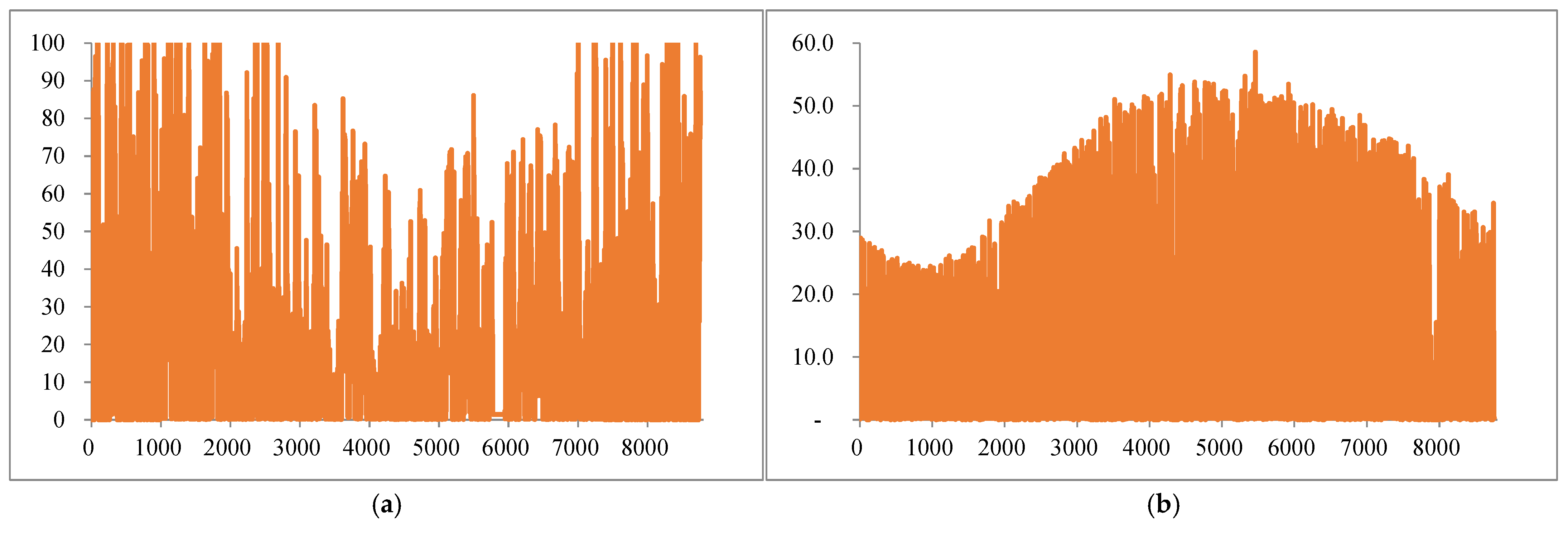
3. Results and Discussion
3.1. Power Generation Structure
3.2. Energy Import
3.3. Storage Utilization
3.4. CO2 Emission
3.5. Costs
4. Policy Implications
- Flexible and cost-effective solutions should be provided for battery energy storage capacity, such as allowing renewable energy projects to lease independent storage capacity, reducing upfront investment costs. Allowing projects in regions with energy consumption difficulties to lease storage nearby helps reduce logistics and infrastructure costs. Negotiating lease prices and signing long-term contracts make investments more predictable. Additionally, the government should increase financial subsidies for battery energy storage stations and user-side enterprises, drawing from the experiences of provinces and cities such as Hunan, Chongqing, and Anhui [53]. Taking Hunan Province as an example, the energy storage industry in Hunan has entered a stage of large-scale development. In 2023, the ratio of installed energy storage capacity to wind and photovoltaic generation capacity in Hunan reached 17.4% [54], significantly surpassing the national average. To support this growth, Hunan has implemented key policies, including the “14th Five-Year Plan for Renewable Energy Development” [55], the “Hunan Province New Power System Development Plan Outline” [56], and the “Implementation Plan for Carbon Peaking” [57], establishing a strong policy foundation. Additionally, Hunan has introduced subsidy measures to promote advanced energy storage technologies and energy storage station development. These include a reward of 0.15 yuan per kWh for qualifying large-scale energy storage material enterprises based on their annual electricity consumption increase, and 0.3 yuan per kWh for energy storage station operators based on actual discharge amounts.
- Accelerating the market-oriented reform of electricity is also crucial. According to the National Development and Reform Commission’s “Regulations on the Supervision of Full Guaranteed Acquisition of Renewable Energy Power” [58], renewable energy projects should be divided into guaranteed acquisition and market transactions. This study suggests developing a robust green power trading strategy to enable all green energy to be traded online once quotas are met in Jiangxi. By introducing various trading forms such as real-time power markets and long-term contract markets, including intraday and weekly markets, the flexibility of supply and demand matching can be enhanced. At the same time, electricity prices can be dynamically adjusted to reflect market supply and demand, generation costs, and storage technology levels. Additionally, as Lin Boqiang [59] suggested, the green electricity market can be closely integrated with the carbon trading market to achieve mutual offset and recognition of carbon emissions. With reference to the previous analysis, carbon prices can be gradually increased, with an expected reach of $30 per ton by 2035.
- A scientific and strategic layout of the solar–wind–storage system should be established, with strict supervision and approval processes. It is important to configure a reasonable installed capacity ratio for the wind–solar–storage system, without blindly increasing the energy storage proportion. Optimization algorithms, such as linear and integer programming [60], can be used to determine the optimal energy storage capacity and configuration. In regions with a high concentration of renewable energy projects, such as Yuanzhou in Yichun, Poyang in Shangrao, and Jinxian in Nanchang, centralized energy storage facilities are encouraged. In areas with optimal wind and solar power conditions like the Wugong and Wuyi Mountains [61], a higher energy storage ratio should be set to improve the utilization rate of energy storage. For distributed systems, such as rooftop photovoltaics, strict site selection reviews are necessary to ensure optimal resource conditions. Ongoing supervision and technical support should follow installation to improve generation efficiency and maximum availability.
- Efforts in technology research and development should be intensified. Through technologies such as big data, cloud computing, and artificial intelligence, precise forecasting and intelligent regulation of the power system can be achieved, ensuring its stable operation [62]. The power dispatch model for Jiangxi Province can take the form of a multi-stage coordinated dispatching framework [63], Stackelberg game models [64], and other advanced optimization algorithms. Additionally, the dispatch system should consider the energy storage battery lifespan to improve both cost efficiency and the long-term sustainability of the system [65].
- Land planning and management should be optimized by establishing land and ecological compensation mechanisms to safeguard the interests of all stakeholders. The government should mandate environmental impact assessments for all wind–solar–storage projects during the planning phase to minimize ecological disruption. To improve public acceptance, the government should enhance transparency and social support through information disclosure, community engagement, and benefit-sharing mechanisms.
- The integrated development of wind–solar–storage systems, electric vehicles (EVs), and hydrogen energy should be promoted. Jiangxi Province should establish distributed wind–solar–storage systems, leveraging smart grids for real-time coordination with EV charging stations to prioritize clean energy use when wind–solar resources are abundant, drawing on successful models from Hainan [66] and Guangzhou [67]. Additionally, large-scale wind–solar–storage stations can incorporate electrolysis-based hydrogen production systems to convert surplus electricity into hydrogen, ensuring a stable supply of green power for hydrogen refueling stations for new energy vehicles.
5. Conclusions
Author Contributions
Funding
Data Availability Statement
Acknowledgments
Conflicts of Interest
References
- Chen, L.; Msigwa, G.; Yang, M.; Osman, A.I.; Fawzy, S.; Rooney, D.W.; Yap, P.S. Strategies to achieve a carbon neutral society: A review. Environ. Chem. Lett. 2022, 20, 2277–2310. [Google Scholar] [CrossRef] [PubMed]
- Gielen, D.; Boshell, F.; Saygin, D.; Bazilian, M.D.; Wagner, N.; Gorini, R. The role of renewable energy in the global energy transformation. Energy Strategy Rev. 2019, 24, 38–50. [Google Scholar] [CrossRef]
- Al-Shetwi, A.Q. Sustainable development of renewable energy integrated power sector: Trends, environmental impacts, and recent challenges. Sci. Total Environ. 2022, 822, 153645. [Google Scholar] [CrossRef]
- Shi, X.W.; Shi, X.F.; Dong, W.Q.; Zang, P.; Jia, H.Y.; Wu, J.F. Research on energy storage configuration method based on wind and solar volatility. In Proceedings of the 2020 10th International Conference on Power and Energy Systems (ICPES), Chengdu, China, 25–27 December 2020. [Google Scholar]
- Zhou, X.; Yi, J.; Song, R. An overview of power transmission systems in China. Energy 2010, 35, 4302–4312. [Google Scholar] [CrossRef]
- Wang, X.; Lu, Z.; Li, T.; Zhang, P. Carbon-neutral power system transition pathways for coal-dominant and renewable Resource-abundant regions: Inner Mongolia as a case study. Energy Convers. Manag. 2023, 285, 117013. [Google Scholar] [CrossRef]
- Zeng, M.; Peng, L.; Fan, Q.; Zhang, Y. Trans-regional electricity transmission in China: Status, issues and strategies. Renew. Sustain. Energy Rev. 2016, 66, 572–583. [Google Scholar]
- Zhou, H.; Su, Y.; Chen, Y.; Ma, Q.; Mo, W. The China southern power grid: Solutions to operation risks and planning challenges. IEEE Power Energy Mag. 2016, 14, 72–78. [Google Scholar] [CrossRef]
- Xu, Y.; Zhong, Y.X.; Xu, L.T.; Yang, W.J. Research on spatial-temporal characteristics and driving forces of rural settlements in Jiangxi Province. J. Ecol. Rural Environ. 2018, 34, 504–511. [Google Scholar]
- NBS. China Energy Statistical Yearbook 2019–2023; China Statistical Publishing House: Beijing, China, 2023. [Google Scholar]
- CEC. China Electric Power Statistical Yearbook 2021; China Statistical Publishing House: Beijing, China, 2022. [Google Scholar]
- CEC. China Electric Power Statistical Yearbook 2022; China Statistical Publishing House: Beijing, China, 2023. [Google Scholar]
- The Lithium Reserves in Jiangxi Have Risen to the Top Nationwide. Available online: https://www.cnjjwb.com/index.php?s=szb&c=home&m=szb_content&id=18631 (accessed on 19 December 2024).
- The Notice on the Competitive Selection of Additional Photovoltaic Power Generation Projects in 2021. Available online: http://www.shangyou.gov.cn/syxxxgk/xzfwjg/202112/705bb5cd269c4779ab4370cdc758297d.shtml (accessed on 24 January 2025).
- Development Plan for New Energy Storage in Jiangxi Province (2024–2030). Available online: https://www.eesia.cn/contents/113/5470.html (accessed on 19 December 2024).
- Notice on Matters Related to Overdue Construction Projects. Available online: https://www.in-en.com/datas/show.php?itemid=8&nid=32801 (accessed on 24 January 2025).
- Stanley, A.P.; King, J. Optimizing the physical design and layout of a resilient wind, solar, and storage hybrid power plant. Appl. Energy 2022, 317, 119139. [Google Scholar] [CrossRef]
- Lu, X.; Chen, S.; Nielsen, C.P.; Zhang, C.; Li, J.; Xu, H. Combined solar power and storage as cost-competitive and grid-compatible supply for China’s future carbon-neutral electricity system. Proc. Natl. Acad. Sci. USA 2021, 118, e2103471118. [Google Scholar] [CrossRef]
- Zhu, R.; Zhao, A.L.; Wang, G.C.; Xia, X.; Yang, Y. An Energy Storage Performance Improvement Model for Grid-Connected Wind-Solar Hybrid Energy Storage System. Comput. Intell. Neurosci. 2020, 2020, 8887227. [Google Scholar] [CrossRef] [PubMed]
- Zhang, X.; Campana, P.E.; Bi, X.; Egusquiza, M.; Xu, B.; Wang, C.; Egusquiza, E. Capacity configuration of a hydro-wind-solar-storage bundling system with transmission constraints of the receiving-end power grid and its techno-economic evaluation. Energy Convers. Manag. 2022, 270, 116177. [Google Scholar] [CrossRef]
- Zeng, Z.; Gao, X.; Fang, B.; Zhang, T.; Zhu, Y. Optimal revenue sharing model of a wind–solar-storage hybrid energy plant under the green power trading market. Front. Energy Res. 2024, 12, 1459090. [Google Scholar] [CrossRef]
- Srinivasan, S.; Kumarasamy, S.; Andreadakis, Z.E.; Lind, P.G. Artificial intelligence and mathematical models of power grids driven by renewable energy sources: A survey. Energies 2023, 16, 5383. [Google Scholar] [CrossRef]
- Ahmed, A.; Khalid, M. A review on the selected applications of forecasting models in renewable power systems. Renew. Sustain. Energy Rev. 2019, 100, 9–21. [Google Scholar] [CrossRef]
- Misak, S.; Prokop, L.; Dvorsky, J. Optimizing the mathematical model for prediction of energy production in wind power plants. Prz. Elektrotechniczny 2011, 87, 74–78. [Google Scholar]
- Fan, H.; Wu, H.; Li, S.; Han, S.; Ren, J.; Huang, S.; Zou, H. Optimal Scheduling Method of Combined Wind–Photovoltaic–Pumped Storage System Based on Improved Bat Algorithm. Processes 2025, 13, 101. [Google Scholar] [CrossRef]
- Gbadega, P.A.; Balogun, O.A. Modeling and control of grid-connected solar-wind hybrid micro-grid system with multiple-input ćuk DC-DC converter for household & high power applications. Int. J. Eng. Res. Afr. 2022, 58, 191–224. [Google Scholar]
- Rafiq, M.A.; Zhang, L.; Kung, C.C. A Techno-Economic Analysis of Solar Energy Development Under Competing Technologies: A Case Study in Jiangxi, China. SAGE Open 2022, 12, 21582440221108166. [Google Scholar] [CrossRef]
- Gao, Y.; Gao, B.; Chen, S. Analysis of Transient Voltage Stability of Wind Power Accessing Jiangxi Power Grid. In Proceedings of the 2018 5th International Conference on Information, Cybernetics, and Computational Social Systems (ICCSS), Hangzhou, China, 16–19 August 2018. [Google Scholar]
- Le, Q.; Xie, Z.; Liu, M.; Mao, Y.; Yan, H. Strategies and Suggestions for Improving the Accommodation Capacity of New Energy Resources in Jiangxi Province. In Proceedings of the 2024 9th Asia Conference on Power and Electrical Engineering (ACPEE), Shanghai, China, 11–13 April 2024. [Google Scholar]
- Tang, X.F.; Luo, X. Research on energy policies of Jiangxi province under the dual-carbon constraints. Front. Environ. Sci. 2022, 10, 986385. [Google Scholar]
- Wambui, V.; Njoka, F.; Muguthu, J.; Ndwali, P. Scenario analysis of electricity pathways in Kenya using Low Emissions Analysis Platform and the Next Energy Modeling system for optimization. Renew. Sustain. Energy Rev. 2022, 168, 112871. [Google Scholar] [CrossRef]
- Zou, Q.; Zeng, G.P.; Zou, F.; Zhou, S. Carbon emissions path of public buildings based on LEAP model in Changsha city (China). Sustain. Futures 2024, 8, 100231. [Google Scholar] [CrossRef]
- Cai, L.; Duan, J.; Lu, X.; Luo, J.; Yi, B.; Wang, Y.; Wang, L. Pathways for electric power industry to achieve carbon emissions peak and carbon neutrality based on LEAP model: A case study of state-owned power generation enterprise in China. Comput. Ind. Eng. 2022, 170, 108334. [Google Scholar] [CrossRef]
- Reza, M.; Setiawan, A.A.; Waluyo, J. Energy Transition Analysis and Climate Action Strategy in the Power Sector: A Case Study of the Java-Bali System. J. Phys. Conf. Ser. 2024, 2828, 012004. [Google Scholar] [CrossRef]
- Handayani, K.; Overland, I.; Suryadi, B.; Vakulchuk, R. Integrating 100% renewable energy into electricity systems: A net-zero analysis for Cambodia, Laos, and Myanmar. Energy Rep. 2023, 10, 4849–4869. [Google Scholar] [CrossRef]
- Teola, L.; Tio, A.E.; Pedrasa, M.A. A Leap Energy Model of the Philippines’ Luzon Grid: Integration and Assessment of the Impact of Utility-Scale Energy Storage Systems. In Proceedings of the 2023 IEEE International Conference on Environment and Electrical Engineering and 2023 IEEE Industrial and Commercial Power Systems Europe (EEEIC/I&CPS Europe), Madrid, Spain, 6–9 June 2023. [Google Scholar]
- CEC. China Electric Power Statistical Yearbook 2013–2023; China Statistical Publishing House: Beijing, China, 2023. [Google Scholar]
- Typical Power Load Curves of Provincial-Level Power Grids. Available online: https://www.ndrc.gov.cn/xwdt/tzgg/202012/P020201202546044875868.pdf (accessed on 19 December 2024).
- Kurz, W.A.; Dymond, C.C.; White, T.M.; Stinson, G.; Shaw, C.H.; Rampley, G.J.; Smyth, C.; Simpson, B.N.; Neilson, E.T.; Trofymow, J.A.; et al. CBM-CFS3: A Model of Carbon-Dynamics in Forestry and Land-Use Change Implementing IPCC Standards. Ecol. Model. 2009, 220, 480–504. [Google Scholar] [CrossRef]
- Zhuo, Z.; Du, E.; Zhang, N.; Nielsen, C.P.; Lu, X.; Xiao, J.; Kang, C. Cost increase in the electricity supply to achieve carbon neutrality in China. Nat. Commun. 2022, 13, 3172. [Google Scholar] [CrossRef]
- Ma, X.; Zhai, Y.; Zhang, T.; Yao, X.; Hong, J. What changes can solar and wind power bring to the electrification of China compared with coal electricity: From a cost-oriented life cycle impact perspective. Energy Convers. Manag. 2023, 289, 117162. [Google Scholar] [CrossRef]
- Shen, W.; Chen, X.; Qiu, J.; Hayward, J.A.; Sayeef, S.; Osman, P.; Dong, Z.Y. A comprehensive review of variable renewable energy levelized cost of electricity. Renew. Sustain. Energy Rev. 2020, 133, 110301. [Google Scholar] [CrossRef]
- He, G.; Lin, J.; Sifuentes, F.; Liu, X.; Abhyankar, N.; Phadke, A. Rapid cost decrease of renewables and storage accelerates the decarbonization of China’s power system. Nat. Commun. 2020, 11, 2486. [Google Scholar] [CrossRef]
- He, Y.; Chen, Y.; Liu, Y.; Liu, H.; Liu, D.; Sun, C. Analysis of the cost of electricity per kWh and cost per kilometer for energy storage. Adv. Technol. Electr. Eng. Energy 2019, 38, 1–9. [Google Scholar]
- China Photovoltaic Industry Development Roadmap (2023–2024). Available online: https://www.chinapv.org.cn/Industry/resource_1380.html (accessed on 4 January 2025).
- Notice on the Issuance of the Carbon Peak Implementation Plan for Jiangxi Province. Available online: https://www.ndrc.gov.cn/fggz/hjyzy/tdftzh/202208/t20220808_1332757.html (accessed on 19 December 2024).
- Notice on the Issuance of the 14th Five-Year Energy Development Plan for Jiangxi Province. Available online: https://www.nc.gov.cn/ncszf/zxfzgh/202308/6ae49a0d50e64707831d72172c32f5fa.shtml (accessed on 19 December 2024).
- Dollinger, B.; Dietrich, K. Storage systems for integrating wind and solar energy in Spain. In Proceedings of the 2013 International Conference on Renewable Energy Research and Applications (ICRERA), Madrid, Spain, 20–23 October 2013. [Google Scholar]
- Gangopadhyay, A.; Seshadri, A.K.; Patil, B. Wind-solar-storage trade-offs in a decarbonizing electricity system. Appl. Energy 2024, 353, 121994. [Google Scholar] [CrossRef]
- Chen, P.; Wang, X.; Yang, Z.; Shi, C. Research on Spatial Heterogeneity, Impact Mechanism, and Carbon Peak Prediction of Carbon Emissions in the Yangtze River Delta Urban Agglomeration. Energies 2024, 17, 19961073. [Google Scholar] [CrossRef]
- Branker, K.; Pathak, M.J.M.; Pearce, J.M. A review of solar photovoltaic levelized cost of electricity. Renew. Sustain. Energy Rev. 2011, 15, 4470–4482. [Google Scholar] [CrossRef]
- Peng, Y.; Luo, Y.; Xu, Z.; Jin, T. Ecological impact study of centralized large-scale photovoltaic and wind power plants: Progress and prospects. Biodiversity 2024, 32, 23212. [Google Scholar]
- Overview of Subsidy Requirements for Energy Storage Integration in New Energy Projects by Province in 2023. Available online: https://www.china5e.com/news/news-1152821-1.html (accessed on 19 December 2024).
- Research on the Integrated Development of Wind, Solar, and Energy Storage in Hunan Province. Available online: http://www.nrdc.cn/Public/uploads/2024-11-07/672c3fa8941de.pdf (accessed on 7 December 2024).
- 14th Five-Year Plan for Renewable Energy Development in Hunan Province. Available online: https://fgw.hunan.gov.cn/fgw/xxgk_70899/zcfg/gfxwj/202206/t20220627_26526958.html (accessed on 7 December 2024).
- Hunan Province New Power System Development Plan Outline. Available online: https://www.hunan.gov.cn/hnszf/xxgk/wjk/szfbgt/202312/t20231227_32612225.html (accessed on 7 December 2024).
- Implementation Plan for Carbon Peaking in Hunan Province. Available online: https://hunan.gov.cn/hnszf/xxgk/wjk/szfwj/202211/t20221107_29118520.html (accessed on 7 December 2024).
- Regulations on the Supervision of Full Guaranteed Acquisition of Renewable Energy Power. Available online: https://www.ndrc.gov.cn/xxgk/zcfb/fzggwl/202403/t20240315_1364966.html (accessed on 19 December 2024).
- Promoting Green Power Trading and Effectively Connecting ‘Electricity-Certificates-Carbon’. Available online: https://cicep.xmu.edu.cn/info/1012/21181.htm (accessed on 19 December 2024).
- Du, X.; Wu, Z.; Zou, L.; Tang, Y.; Fang, C.; Wang, C. Optimal configuration of integrated energy systems based on mixed integer linear programming. In Proceedings of the 2021 IEEE Asia-Pacific Conference on Image Processing, Electronics and Computers (IPEC), Dalian, China, 14–16 April 2021. [Google Scholar]
- Wu, Q.; Nie, Q.S.; Zhou, R.W.; Xu, W.M. Analysis of wind energy resources reserves and characteristics in mountain area of Jiangxi Province. J. Nat. Resour. 2013, 28, 1605–1614. [Google Scholar]
- Zhang, S.; Ma, C.; Yang, Z.; Wang, Y.; Wu, H.; Ren, Z. Joint scheduling strategy of wind-solar-storage system based on deep deterministic policy gradient algorithm. China Electr. Power 2023, 56, 68–76. [Google Scholar]
- Yang, Z.; Ren, Z.; Li, H.; Sun, Z.; Feng, J.; Xia, W. A multi-stage stochastic dispatching method for electricity-hydrogen integrated energy systems driven by model and data. Appl. Energy 2024, 371, 123668. [Google Scholar] [CrossRef]
- Zhong, J.; Li, Y.; Wu, Y.; Cao, Y.; Li, Z.; Peng, Y.; Shahidehpour, M. Optimal operation of energy hub: An integrated model combined distributionally robust optimization method with Stackelberg game. IEEE Trans. Sustain. Energy 2023, 14, 1835–1848. [Google Scholar] [CrossRef]
- Li, Z.; Yu, J.; Yang, Z.; Li, W.; Fan, X. Economic dispatch of power systems with accurate consideration of large-scale energy storage battery lifespan. Proc. CSEE 2023, 43, 7371–7383. [Google Scholar]
- Hainan Province Hydrogen Energy Industry Development Plan (2023–2035). Available online: https://plan.hainan.gov.cn/sfgw/0503/202401/10f0e16031ec43ca81435976a5582f91/files/f59cd3aa929742109b6f9b3bc56d2bcb.pdf (accessed on 15 February 2025).
- Implementation Opinions on Accelerating the Promotion and Application of New Energy Vehicles. Available online: https://www.gd.gov.cn/gkmlpt/content/0/144/post_144845.html (accessed on 15 February 2025).
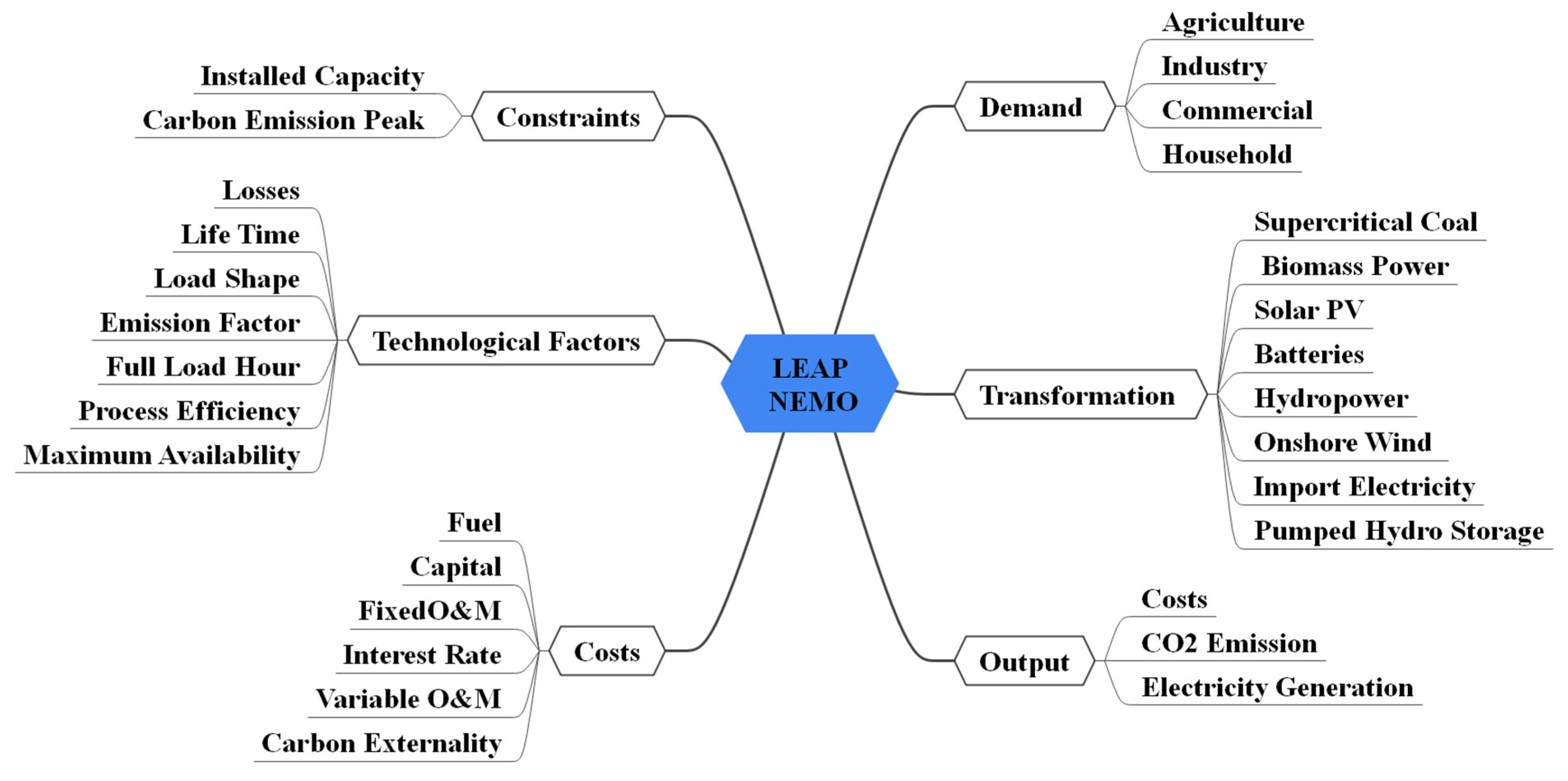
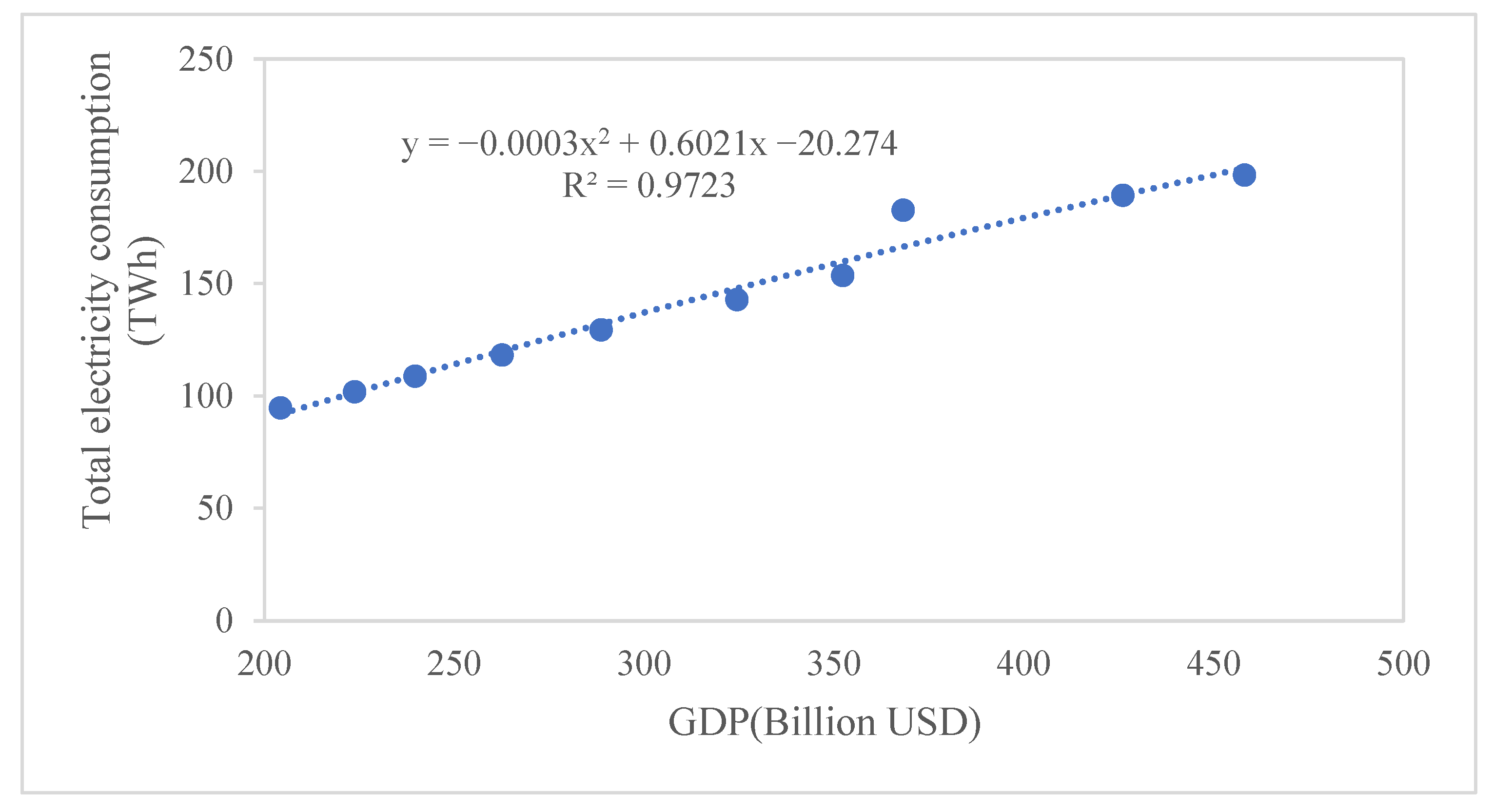
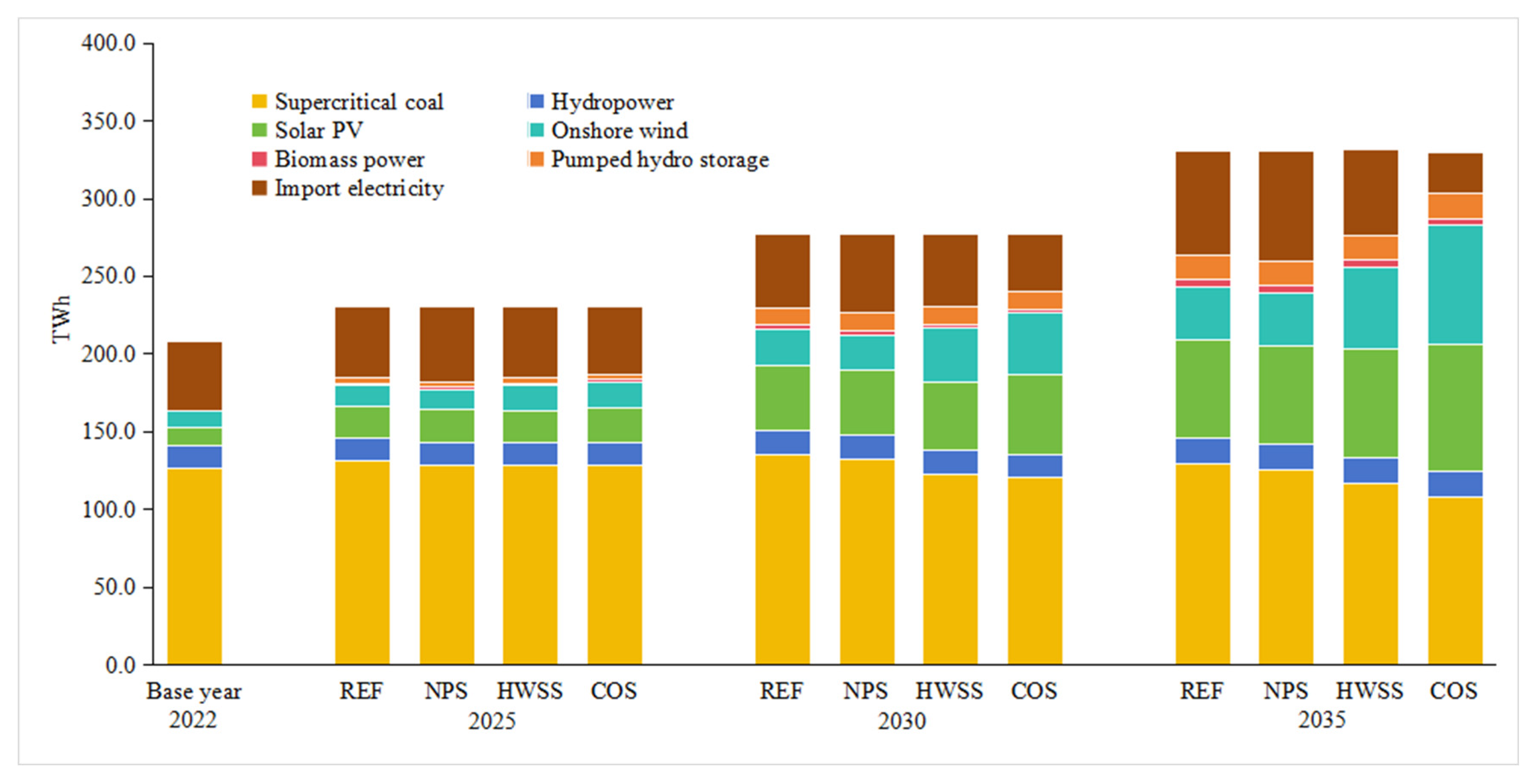
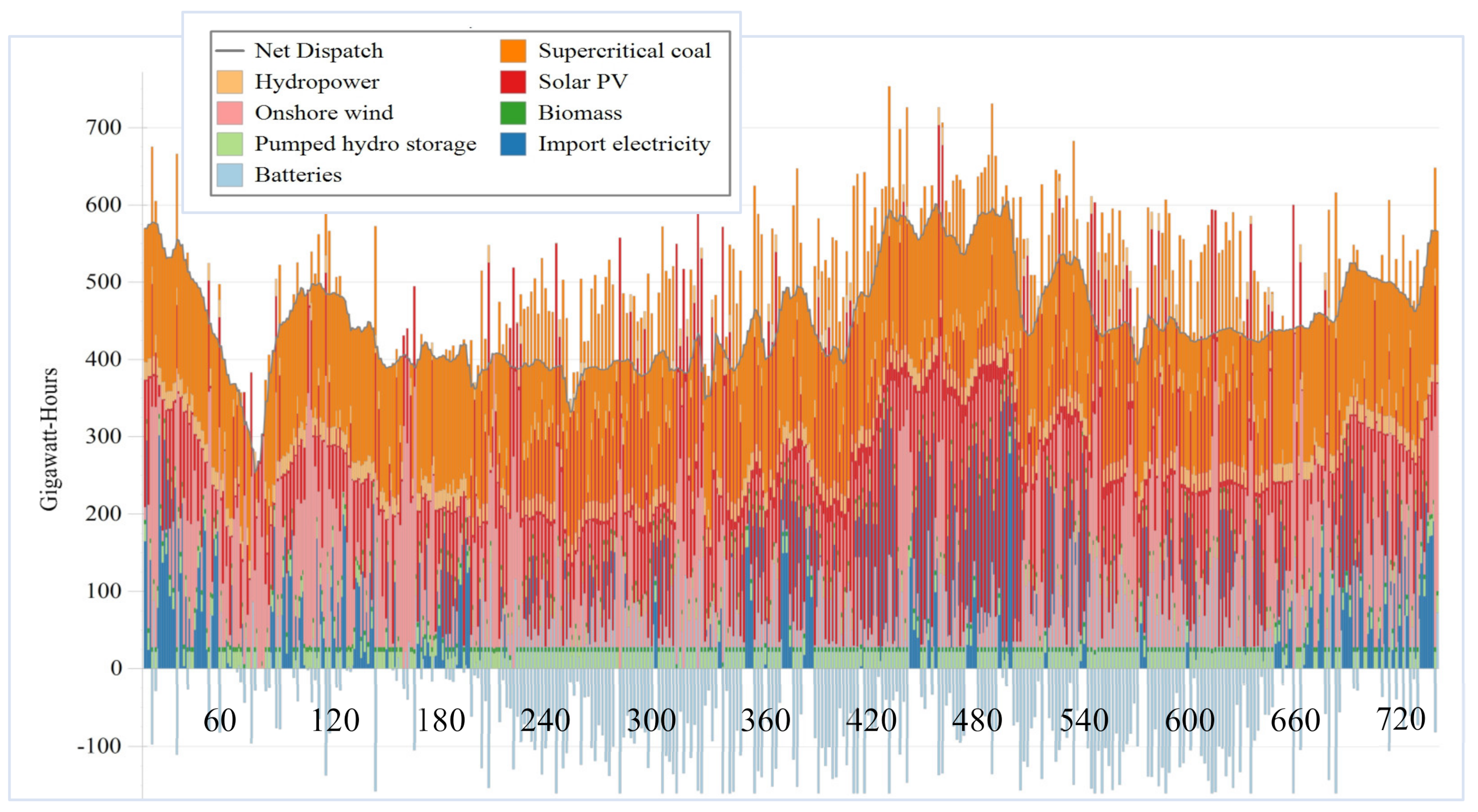
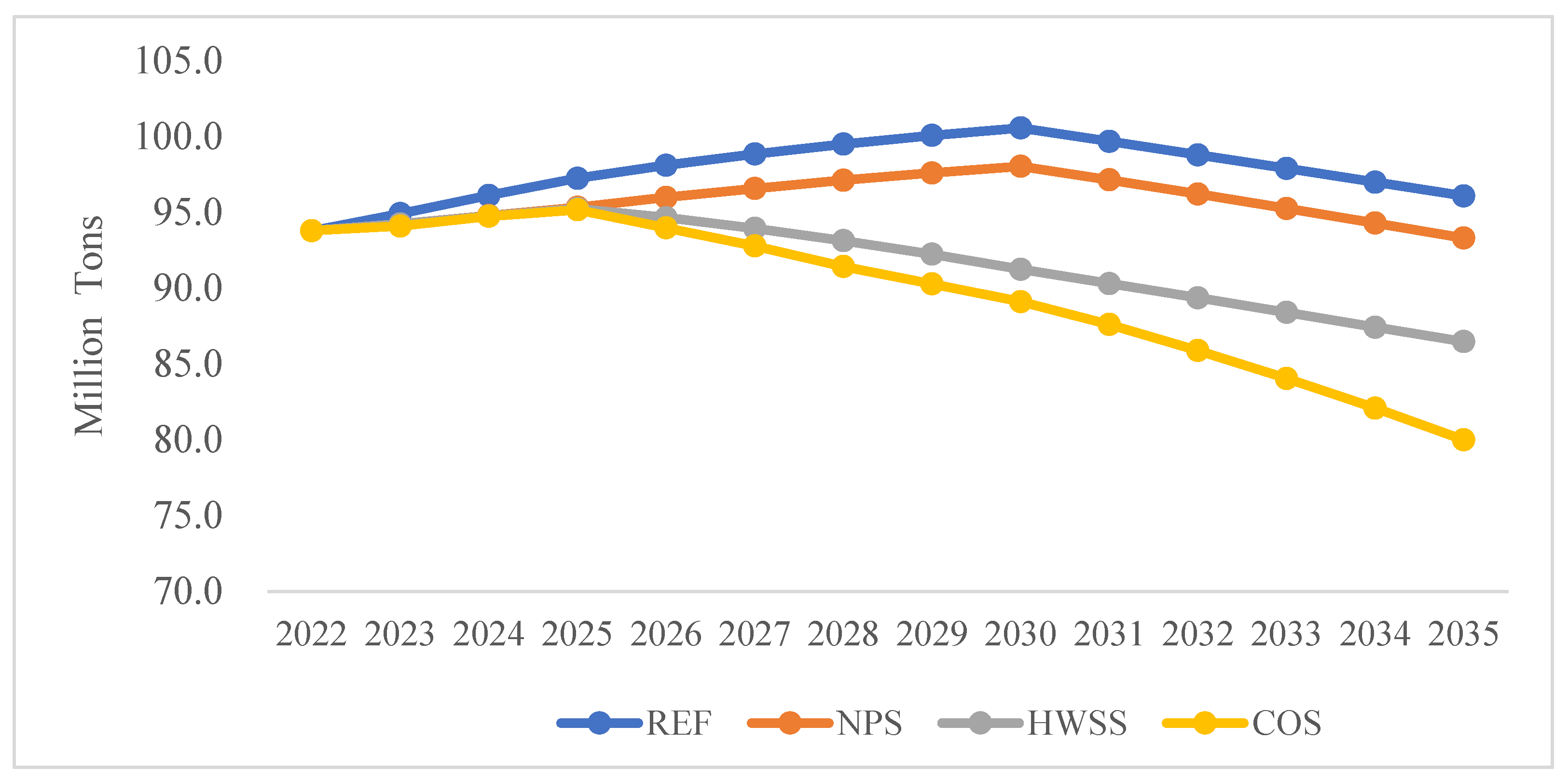

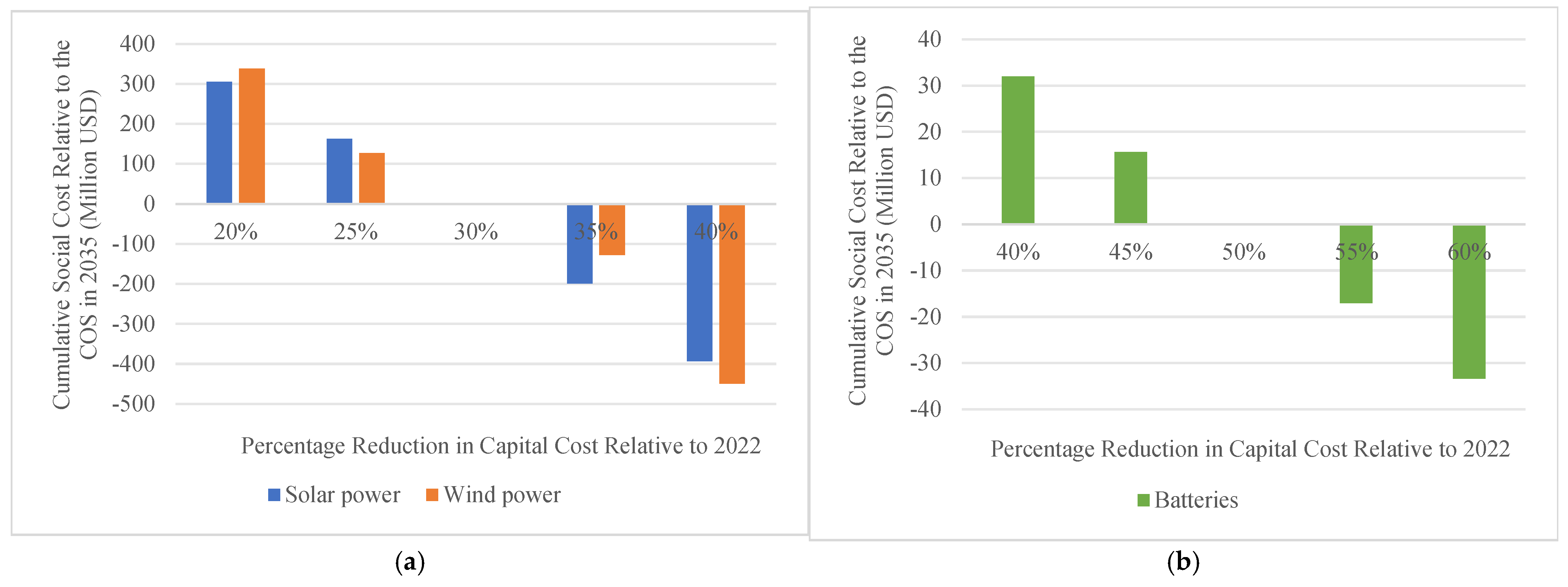
| Technology | Life Time (Year) | Maximum Availability (%) | Process Efficiency (%) | Interest Rate (%) | Capital Cost ($/kW) | Fixed O&M Cost ($/kW) | Variable O&M Cost ($/MWh) | Fuel Cost ($) |
|---|---|---|---|---|---|---|---|---|
| Supercritical coal | 30 | 48 | 45 | 5 | 3112 | 71.8 | 7.3 | 109.3/ ton |
| Biomass power | 30 | 20 | 40 | 5 | 2149 | 47.9 | 3.0 | - |
| Solar PV | 30 | variable | 23 | 5 | 435 | 14.4 | 2.0 | - |
| Hydropower | 50 | 23 | 80 | 5 | 1793 | 37.7 | 6.5 | - |
| Onshore wind | 30 | variable | 40 | 5 | 714 | 42.2 | 2.0 | - |
| Batteries | 10 | 90 | 90 | 5 | 237 | 34.1 | 2.3 | - |
| Pumped hydro storage | 50 | 13 | 65 | 5 | 824 | 50.0 | 5.0 | - |
| Import electricity | 30 | 100 | 100 | 5 | - | - | - | 65/MWh |
| REF | NPS | HWSS | COS | |||
|---|---|---|---|---|---|---|
| Installed Capacity (GW) | Wind and Solar | 2025 | 31.0 | 31.0 | 32.5 | 34.0 |
| 2030 | 60.0 | 60.0 | 68.0 | 72.0 | ||
| 2035 | 90.0 | 90.0 | 108.0 | 118.0 | ||
| Batteries | 2025 | 1.0 | 1.5 * | 1.5 * | 3 * | |
| 2030 | 2.0 | 3.0 * | 3.0 * | 6.0 * | ||
| 2035 | 3.0 | 6.0 * | 6.0 * | 12.0 * | ||
| Carbon Emission | 2030 vs. 2022: +10% †, 2035 vs. 2030: −5% * | 2030 vs. 2022: +5% †, 2035 vs. 2030: −5% * | 2030 vs. 2022: 0% †, 2035 vs. 2030: −5% * | 2030 vs. 2022: −5% †, 2035 vs. 2030: −5% * | ||
| REF | NPS | HWSS | COS | ||
|---|---|---|---|---|---|
| Coal (Million tons) | 2022 | 33.6 | |||
| 2030 | 37.0 | (−0.9) | (−3.4) | (−4.2) | |
| 2035 | 35.4 | (−1.0) | (−3.5) | (−5.9) | |
| Electricity (TWh) | 2022 | 45.0 | |||
| 2030 | 47.3 | (+3.5) | (−1.4) | (−10.7) | |
| 2035 | 67.0 | (+4.0) | (−12.2) | (−40.0) | |
| REF | NPS | HWSS | COS | |
|---|---|---|---|---|
| 2022 | 32.3 | - | - | - |
| 2025 | 98.3 | (+8.6) | (+19.7) | (+210.5) |
| 2030 | 400.2 | (+92.0) | (+98.0) | (+519.0) |
| 2035 | 611.4 | (+260.2) | (+545.2) | (+1499.8) |
| REF | NPS | HWSS | COS | |
|---|---|---|---|---|
| 2022 | 93.8 | - | - | |
| 2025 | 97.3 | (−2.0) | (−2.0) | (−2.1) |
| 2030 | 101.2 | (−2.6) | (−9.3) | (−12.1) |
| 2035 | 96.1 | (−2.8) | (−9.6) | (−16.1) |
| REF | NPS | HWSS | COS | |
|---|---|---|---|---|
| Hydropower | 29.1 | - | - | |
| Biomass power | 60.9 | - | - | - |
| Pumped hydro storage | 69.4 | - | - | - |
| Supercritical coal | 50.4 | (−0.3) | (−0.6) | (+0.2) |
| Solar PV | 28.9 | - | (+0.5) | (−2.7) |
| Onshore wind | 29.5 | - | (−0.9) | (−4.7) |
| Batteries | 50.6 | (−3.3) | (−3.3) | (−24.9) |
Disclaimer/Publisher’s Note: The statements, opinions and data contained in all publications are solely those of the individual author(s) and contributor(s) and not of MDPI and/or the editor(s). MDPI and/or the editor(s) disclaim responsibility for any injury to people or property resulting from any ideas, methods, instructions or products referred to in the content. |
© 2025 by the authors. Licensee MDPI, Basel, Switzerland. This article is an open access article distributed under the terms and conditions of the Creative Commons Attribution (CC BY) license (https://creativecommons.org/licenses/by/4.0/).
Share and Cite
Xiao, Y.; Yang, C.; Chen, T.; Lei, M.; Wattana, S.; Wattana, B. Strategies of a Wind–Solar–Storage System in Jiangxi Province Using the LEAP–NEMO Framework for Achieving Carbon Peaking Goals. Energies 2025, 18, 1135. https://doi.org/10.3390/en18051135
Xiao Y, Yang C, Chen T, Lei M, Wattana S, Wattana B. Strategies of a Wind–Solar–Storage System in Jiangxi Province Using the LEAP–NEMO Framework for Achieving Carbon Peaking Goals. Energies. 2025; 18(5):1135. https://doi.org/10.3390/en18051135
Chicago/Turabian StyleXiao, Yao, Caixia Yang, Tao Chen, Mingze Lei, Supannika Wattana, and Buncha Wattana. 2025. "Strategies of a Wind–Solar–Storage System in Jiangxi Province Using the LEAP–NEMO Framework for Achieving Carbon Peaking Goals" Energies 18, no. 5: 1135. https://doi.org/10.3390/en18051135
APA StyleXiao, Y., Yang, C., Chen, T., Lei, M., Wattana, S., & Wattana, B. (2025). Strategies of a Wind–Solar–Storage System in Jiangxi Province Using the LEAP–NEMO Framework for Achieving Carbon Peaking Goals. Energies, 18(5), 1135. https://doi.org/10.3390/en18051135







